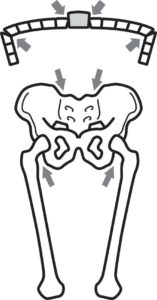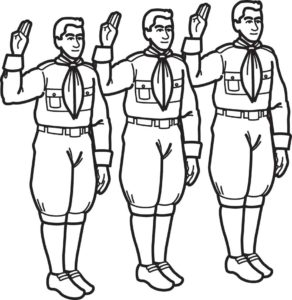
Hip Pain
Chronic hip pain like all chronic joint pain, including the back, is usually caused, or contributed to by prolonged imbalance. Said differently it’s hip pain caused by too much time spent in an unbalanced position. Said again, it’s too much time spent standing in a Type 1 position.
I’ll illustrate why too much time in a Type 1 posture position causes or contributes to chronic hip pain or failure. It will be a closeup of the hip, and the reason for the imbalance and subsequent problems.
Supports and Feet Close Together
If the support foundations of a bridge are somehow moved too close together, the supports are angled out from the bottom. It causes the arch to sag and widen. This puts extra pressure on the upper part of the keystone and the lower parts of the cornerstones.
It will destabilize the structural integrity of the bridge keystone, arch and cornerstones. It can eventually cause the keystone and cornerstones to crumble and the bridge to fail prematurely.

It’s the same with the pelvis and the legs. If the feet are habitually held too close together, the legs are angled out from the bottom. It causes the pelvic arch to sag and widen.
This puts extra pressure on the upper part of the sacroiliac and the lower part of the hip joints. It will destabilize the structural integrity of the sacroiliac, pelvis and hips.
It can eventually cause inflammation of the sacroiliac and hips, and debilitating pain. In the meantime, it contributes to flabby buttocks and hips with the pronounced saddlebags originating at the bottom of the hip joint.
The structural issues are not restricted to the sacroiliac, pelvis and hips. The unbalanced forces result in offset or uneven compression effects on the knees and ankles also.

Example of individuals standing at attention with their feet positioned together.
If habitual, it can cause inflammation and premature breakdown of these joints as well. Adequate positional compensation, if not done to counter dutiful time spent in an unbalanced position, can lead to chronic joint pain or failure.
Supports and Feet Far Apart
The opposite applies if the feet are habitually held far apart.
But the same principles apply.

The opposite effect. Legs held far apart.
If the support foundations of the bridge are somehow moved far apart, the supports are angled in from the bottom. It causes the arch to bow and rise. This puts extra pressure on the lower part of the keystone and the upper parts of the cornerstones.
It will destabilize the structural integrity of the keystone, arch and cornerstones. It can eventually cause the keystone and cornerstones to crumble and the bridge to fail prematurely.
It’s the same with the pelvis and the legs. If the feet are habitually held far apart, the legs are angled in from the bottom. It causes the pelvic arch to bow up and narrow.

The opposite effect. Legs held far apart.
This puts extra pressure on the sacroiliac and parts of the hip joints. It will destabilize the structural integrity of the sacroiliac, pelvis and hips.
It can eventually cause inflammation of the sacroiliac and hips, and debilitating pain. In the meantime, it contributes to flabby buttocks and hips with the pronounced saddlebags originating at the bottom of the hip joint.
The structural issues are not restricted to the sacroiliac, pelvis and hips. The unbalanced forces result in offset or uneven compression effects on the knees and ankles also.
If habitual, it can cause inflammation and premature breakdown of these joints as well. A biologically focused approach to movement and balance, should be practiced to counter dutiful or prolonged time spent in an unbalanced position. If not it can lead to premature chronic joint pain or failure.
Think of this
15 minutes a day spent in an unbalanced position equals 105 minutes a week. This equals 420 minutes or 7 hours a month. This equals 84 hours a year. This equals approximately 672 hours spent in an unbalanced position by the time you are 18 and pretty much set in your postural habits.
That’s 28 days in an unbalanced position. A lot can happen in 28 days. Many people spend much more than 15 minutes a day sitting in a chair or standing in an unbalanced manner.
Exactly where the correct position for the feet to be in most of the time is the subject for the next blog. The angle of the feet relative to the body will also be covered.
So sign up for the newsletter and get a discount. Read the blogs. Get the latest on health research, reviews, science news and my personal quest for a naturally curved, balanced back. Find lifestyle ideas and products for postural rehabilitation. Get those reviews and updates from an independent, non-curriculum point of view.

